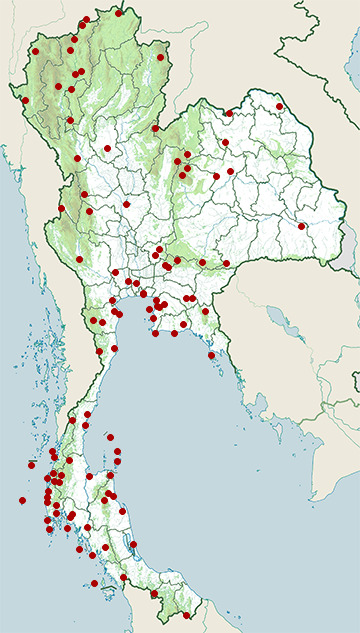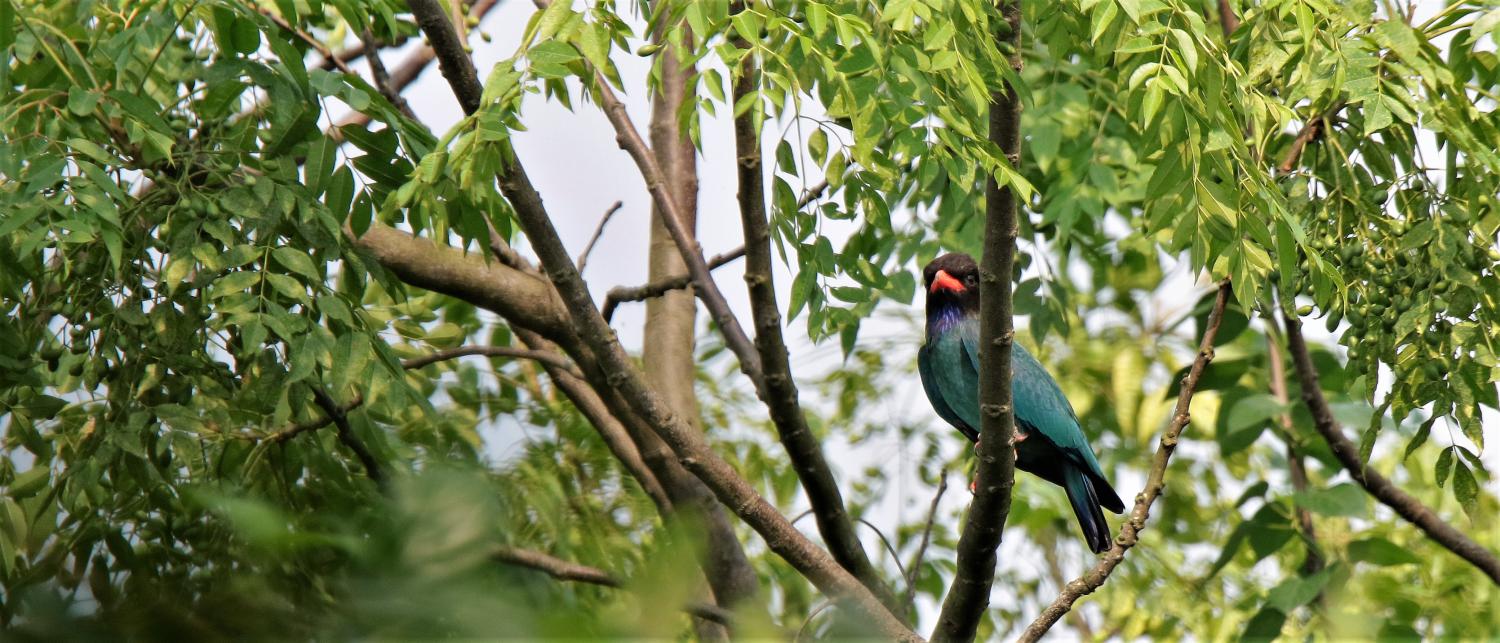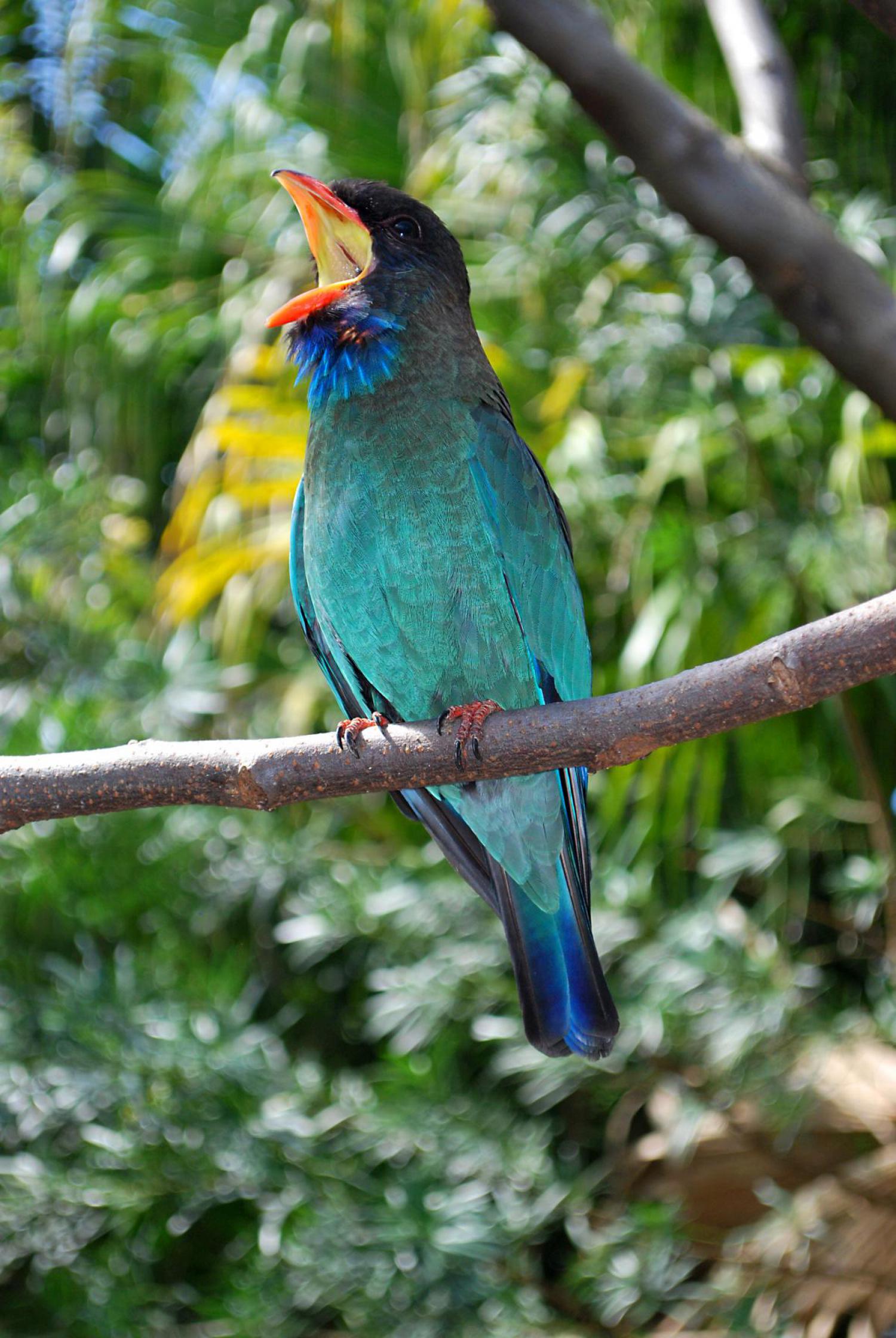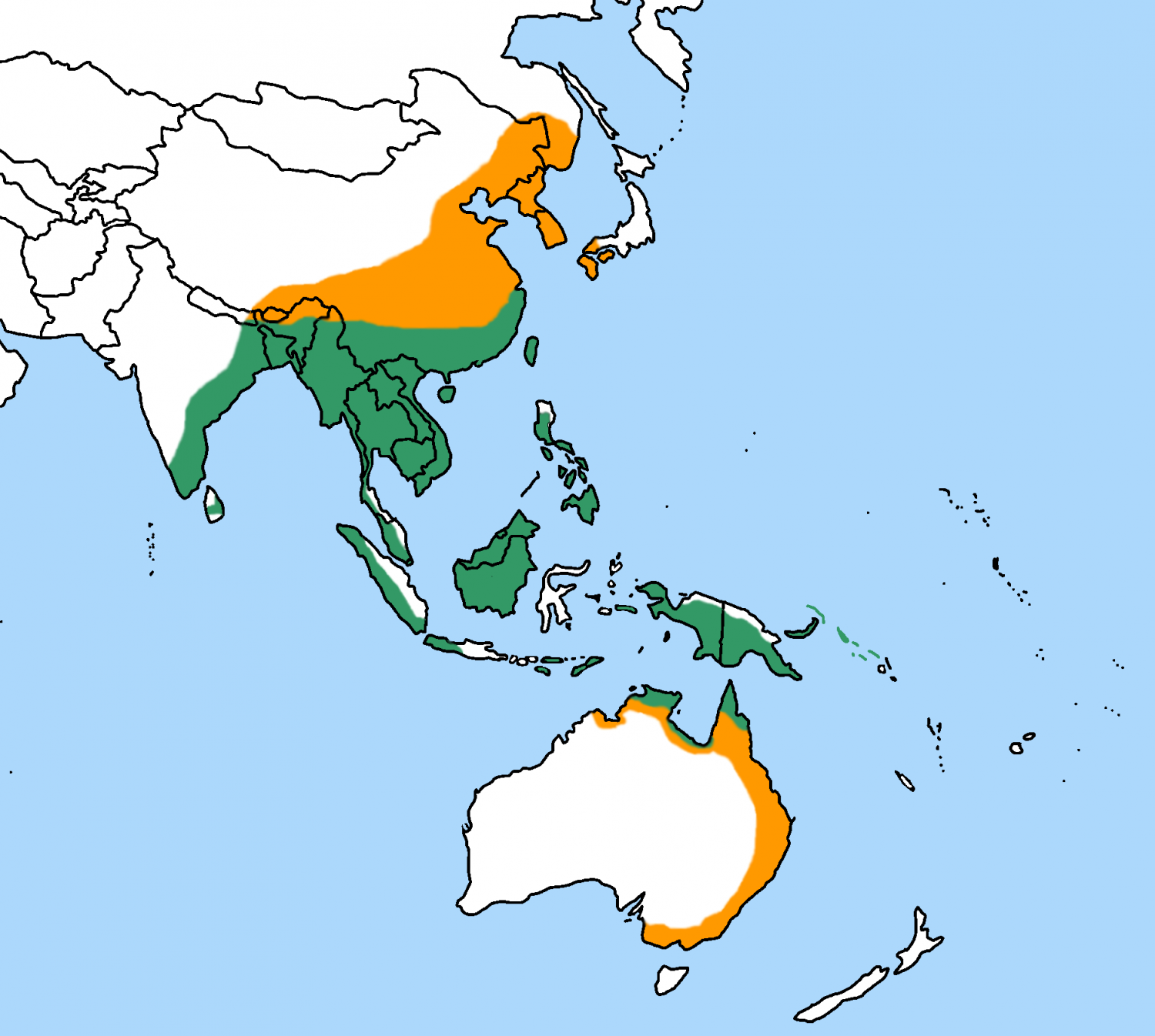Species of Thailand
Oriental dollarbird
Eurystomus orientalis
Carolus Linnaeus, 1766
In Thai: นกตะขาบดง
The Oriental dollarbird (Eurystomus orientalis) is a bird of the roller family, so named because of the distinctive pale blue or white, coin-shaped spots on its wings. It can be found from Australia to Korea, Japan and India.
Taxonomy and systematics
The oriental dollarbird was originally described in the genus Coracias. Formerly, some authorities have also considered the broad-billed roller and the azure dollarbird to have been subspecies of the oriental dollarbird. Alternate names for the oriental dollarbird include the Asian dollarbird, dark roller, dollar roller, dollarbird, eastern broad-billed roller and oriental broad-billed roller. The generic name derives from Ancient Greek eurustomos 'wide-mouthed' and the specific epithet is Latin orientalis 'eastern'.
Subspecies
Ten subspecies are recognized:
- E. o. cyanocollis - Vieillot, 1819: Found from the Himalayas through China to south-eastern Siberia, Korea and Japan
- E. o. orientalis - (Linnaeus, 1766): Found from the southern Himalayas to Indochina, the Malay Peninsula, Sumatra, Java, Borneo and the Philippines
- E. o. laetior - Sharpe, 1890: Found in south-western India
- E. o. gigas - Stresemann, 1913: Found on southern Andaman Islands
- E. o. irisi - Deraniyagala, 1951: Found in Sri Lanka
- E. o. oberholseri - Junge, 1936: Found on Simeulue (off north-western Sumatra)
- Australian roller (E. o. pacificus) - (Latham, 1801): Originally described as a separate species in the genus Coracias. Found on the Lesser Sunda Islands, northern and eastern Australia
- E. o. waigiouensis - Elliot, DG, 1871: Originally described as a separate species. Found on New Guinea, western Papuan islands, D'Entrecasteaux Islands and the Louisiade Archipelago
- E. o. crassirostris - Sclater, PL, 1869: Originally described as a separate species. Found in the Bismarck Archipelago
- E. o. solomonensis - Sharpe, 1890: Originally described as a separate species. Found in the Solomon Islands
Description
The oriental dollarbird has a length of up to 30 cm. It is dark brown but this is heavily washed with a bluish-green sheen on the back and wing coverts. Its belly and undertail coverts are light coloured, and it has glossy bright blue colouring on its throat and undertail. Its flight feathers are a darker blue. Its bill is short and wide and in mature animals is coloured orange-red with a black tip. It has very light blue patches on the outer parts of its wings which are highly visible in flight and for which it is named. The females are slightly duller than the males but overall the two are very similar. Immature birds are much duller than the adults and do not have the blue colouring on their throats. They also have brown bills and feet instead of the red of the adults.
Distribution and habitat
The oriental dollarbird is found from Australia to Japan and India. It breeds in northern and eastern Australia between the months of September and April and winters in New Guinea and nearby islands. The birds prefer open wooded areas with hollow-bearing trees to build nests in.
Behaviour and ecology
The oriental dollarbird is most commonly seen singly with a distinctive upright silhouette on a bare branch high in a tree, from which it hawks for insects, returning to the same perch after a few seconds.
This article uses material from Wikipedia released under the Creative Commons Attribution-Share-Alike Licence 3.0. Eventual photos shown in this page may or may not be from Wikipedia, please see the license details for photos in photo by-lines.
Category / Seasonal Status
BCST Category: Recorded in an apparently wild state within the last 50 years
BCST Seasonal statuses:
- Resident or presumed resident
- Non-breeding visitor
Scientific classification
- Kingdom
- Animalia
- Phylum
- Chordata
- Class
- Aves
- Order
- Coraciiformes
- Family
- Coraciidae
- Genus
- Eurystomus
- Species
- Eurystomus orientalis
Common names
- Thai: นกตะขาบดง
Synonyms
- Eurystomus solomonensis
Conservation status

Least Concern (IUCN3.1)
Photos
Please help us review the bird photos if wrong ones are used. We can be reached via our contact us page.
Range Map

- Amphawa District, Samut Songkhram
- Ao Phang-Nga National Park
- Ban Bueng District, Chonburi
- Bang Lamung District, Chonburi
- Bang Phra Non-Hunting Area
- Bang Pu Recreation Centre
- Bangkok Province
- Bueng Boraped Non-Hunting Area
- Bueng Khong Long Non-Hunting Area
- Chiang Dao Wildlife Sanctuary
- Doi Inthanon National Park
- Doi Lang
- Doi Pha Hom Pok National Park
- Doi Phu Kha National Park
- Doi Saket District, Chiang Mai
- Erawan National Park
- Hala-Bala Wildlife Sanctuary
- Huai Kha Khaeng Wildlife Sanctuary
- Kaeng Khoi District, Saraburi
- Kaeng Krachan District, Phetchaburi
- Kaeng Krachan National Park
- Kaeng Krung National Park
- Kamphaeng Saen District, Nakhon Pathom
- Kanthararom District, Sisaket
- Khanom District, Nakhon Si Thammarat
- Khao Ang Rue Nai Wildlife Sanctuary
- Khao Dinsor (Chumphon Raptor Center)
- Khao Laem Ya - Mu Ko Samet National Park
- Khao Lak - Lam Ru National Park
- Khao Luang National Park
- Khao Nan National Park
- Khao Phanom Bencha National Park
- Khao Phra - Bang Khram Wildlife Sanctuary
- Khao Sam Roi Yot National Park
- Khao Soi Dao Wildlife Sanctuary
- Khao Sok National Park
- Khao Yai National Park
- Khlong Saeng Wildlife Sanctuary
- Khon San District, Chaiyaphum
- Khura Buri District, Phang Nga
- Klaeng District, Rayong
- Ko Chang National Park
- Ko Lanta National Park
- Ko Libong
- Ko Phayam
- Ko Phra Thong
- Ko Samui District, Surat Thani
- Ko Sichang District, Chonburi
- Ko Tao
- Kui Buri National Park
- Laem Pak Bia
- Laem Son National Park
- Lan Sang National Park
- Mae Ping National Park
- Mae Wong National Park
- Mu Ko Chumphon National Park
- Mueang Chiang Mai District, Chiang Mai
- Mueang Chonburi District, Chonburi
- Mueang Khon Kaen District, Khon Kaen
- Mueang Krabi District, Krabi
- Mueang Nakhon Nayok District, Nakhon Nayok
- Mueang Nong Khai District, Nong Khai
- Mueang Phang Nga District, Phang Nga
- Mueang Phetchaburi District, Phetchaburi
- Mueang Phuket District, Phuket
- Mueang Sukhothai District, Sukhothai
- Mueang Surat Thani District, Surat Thani
- Nam Nao National Park
- Nam Phong National Park
- Namtok Mae Surin National Park
- Namtok Sam Lan National Park
- Non Din Daeng District, Buriram
- Nong Bong Khai Non-Hunting Area
- Pa Sang District, Lamphun
- Pak Phanang District, Nakhon Si Thammarat
- Pak Phli District, Nakhon Nayok
- Pha Daeng National Park
- Phi Phi Islands
- Phu Foi Lom National Park
- Phu Khiao Wildlife Sanctuary
- Phu Kradueng National Park
- Phu Suan Sai National Park
- Phutthamonthon District, Nakhon Pathom
- Salawin National Park
- Samae San Island
- Samut Prakan Province
- San Kala Khiri National Park
- Sathing Phra District, Songkhla
- Si Racha District, Chonburi
- Similan Islands
- Sirinat National Park
- Sri Phang Nga National Park
- Surin Islands
- Takua Pa District, Phang Nga
- Tarutao National Marine Park
- Tha Sala District, Nakhon Si Thammarat
- Tha Takiap District, Chachoengsao
- Thai Mueang District, Phang Nga
- Thale Ban National Park
- Than Sadet - Koh Pha-Ngan National Park
- Thap Lan National Park
- Thung Yai Naresuan Wildlife Sanctuary
- Wang Mai Forest Restoration Project
- Yan Ta Khao District, Trang


